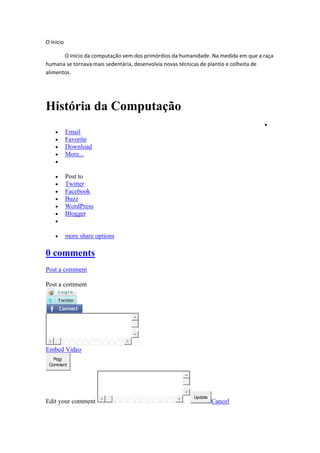
Novo(A) Documento Do Microsoft Office Word
- 1. O ínicio O início da computação vem dos primórdios da humanidade. Na medida em que a raça humana se tornava mais sedentária, desenvolvia novas técnicas de plantio e colheita de alimentos. História da Computação • • Email • Favorite • Download • More... • • Post to • Twitter • Facebook • Buzz • WordPress • Blogger • • more share options 0 comments Post a comment Post a comment Embed Video Post Comment Update Edit your comment Cancel
- 2. no notes for slide #1 1 Favorite • fabio123dias favorited this 6 months ago História da Computação - Presentation Transcript 1. História da Computação Ricardo Jurczyk Pinheiro Faculdades Paraíso 2. O início - ábaco o Criado pelos babilônicos o Século VIII AC. o Objetivo: Facilitar as contas o Uma armação de madeira com contas. 3. Século XVI (1617) o John Napier cria os logaritmos o Tábua de logaritmos o Depois estendido para as réguas de cálculo . 4. Século XVI (1642) o Blaise Pascal, matemático e filósofo francês o Construiu a Pascaline. o Máquina de somar e subtrair o Uso de engrenagens Leibnitz aperfeiçoou a máquina: Adição, subtração, multiplicação, divisão e raiz quadrada. 5. Século XVIII (1801) o Teares automáticos o Joseph Jacquard o Uso de cartões perfurados o Conceito de programação 6. Século XIX (1822) o Máquina de diferenças
- 3. o Charles Babbage o UCP, memória e periféricos de E/S o Máquina analítica (1848) o Não foi completada. o Ada Byron - primeira programadora 7. Século XIX (1854 e 1890) o Tabuladora mecânica o Herman Hollerith o Usado no censo norte-americano de 1890 o George Boole o Criador da Álgebra Booleana 8. Século XX (1924 e 1936) A TLM (empresa montada por Hollerith) funde-se a duas outras empresas e forma a IBM o Alan Turing, matemático inglês o Máquinas capazes de resolver todos os tipos de problemas o Máquina de Turing 9. Século XX (1941 e 1943) o Calculadora eletrônica Z3 o Konrad Zuse (Alemanha) o Usado na Segunda Guerra Mundial o Colossus (Inglaterra) o Projeto secreto, feito por Turing o Usado para quebrar códigos dos nazistas 10. 1a geração (1944-1954) o Uso de válvulas o Grandes o Pesados o Lentos o Gastam muita energia o Dissipam muito calor o Programador precisa conhecer o hardware Mark I ENIAC UNIVAC 11. 2a geração (1954-1964) o 1947 - criação do transístor o Menores o Gastam menos energia (100W) o Dissipam menos calor o Mais rápidos o Entrada de dados por teclados o Primeiras linguagens de programação (FORTRAN, COBOL, BASIC) Tradic 12. 3a geração (1964-1971) o 1958 - criação do circuito integrado (uma pastilha com vários transistores) o Primeiros minicomputadores o Menores
- 4. o Mais baratos o Mais poderosos 13. Linha do tempo: o 1964 - Criada a tabela ASCII o 1965 - Início do projeto MULTICS o 1966 - Primeiro disco rígido o 1967 - Primeiro floppy-drive o 1968 - Criado o UNICS, no Bell Labs o 1969 - Montada a ARPAnet, protótipo da Internet o 1970 - Criada a linguagem Pascal 14. 4a geração (1971-hoje) o 1971 - A Intel faz o primeiro microprocessador o (A UCP inserida dentro de um circuito integrado) o Circuitos integrados em larga escala o Miniaturização dos componentes o Queda nos preços e custos o Criação do microcomputador 15. Linha do tempo: Anos 70 o 1973 - rede padrão Ethernet o 1975 - Altair 8800; início da Micro-soft (interpretador BASIC), Zilog Z80 o 1976 - Apple I e CP/M o 1977 - Apple II o 1979 - Visicalc, a primeira planilha o 1980 - Primeiro HD para micros 16. Linha do tempo: Anos 80 o 1981 - IBM-PC, com MS-DOS, Microsistemas (Brasil), Sinclair ZX81(Inglaterra). o 1982 - primeiros clones de PC. o 1983 - MSX (Japão). o 1984 - Intel 286, Macintosh (Apple), drive de 3,5 pol, CDROM o 1985 - Windows 1.0, MSX no Brasil, impressora laser 17. Linha do tempo: Anos 80 o 1986 - Intel 386 o 1987 - IBM PS/2, OS/2, o placa de som o 1988 - NeXT, impressora o jato de tinta o 1989 - Sound Blaster, 486 o 1990 - America Online, o Windows 3.0 18. Linha do tempo: Anos 90 o 1991 - Linux, PowerPC. o 1992 - Fim da reserva de mercado (Brasil). o 1993 - Apple Newton (PDA), Intel Pentium. o 1994 - Netscape, Zip-Drive, o 1995 - “Toy Story”, Windows 95, boom da Internet. 19. Linha do tempo: Anos 90 o 1996 - Cyrix M2 o 1997 - Pentium II, gravador de CD-ROM
- 5. o 1998 - Windows 98, AMD K6-2, iMac, processo anti-truste contra a Microsoft. o 1999 - Pentium III, crescimento do Linux. o 2000 - Windows 2000